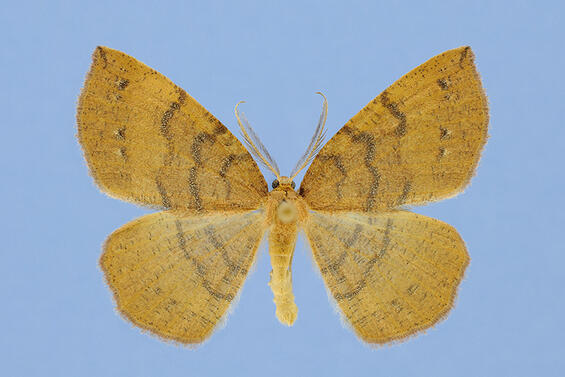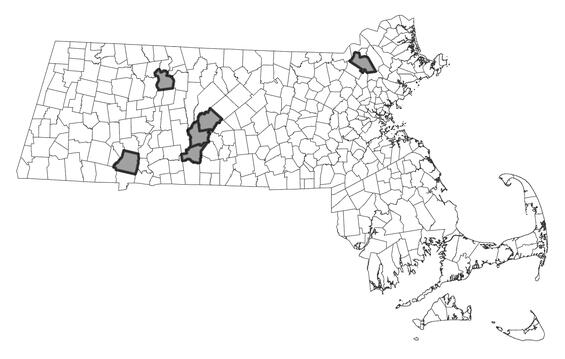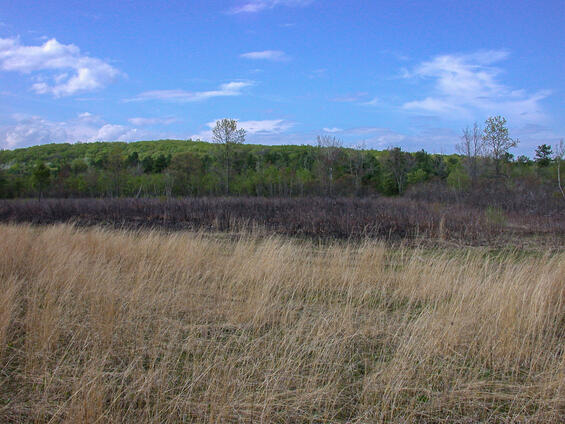- Scientific name: Apodrepanulatrix liberaria
- Species of Greatest Conservation Need (MA State Wildlife Action Plan)
- Endangered (MA Endangered Species Act List)
Description

New Jersey tea inchworm, Apodrepanulatrix liberaria.
The New Jersey tea inchworm (Apodrepanulatrix liberaria) is a geometrid moth with a wingspan of 25-31 mm (1.0-1.2 inches) (Rindge 1949). The wings are variably colored, ranging from pale yellow to tan to dark, reddish-tan (as in the individual figured here). The forewing subterminal line is broken into dark brown dots. The forewing postmedial, median, and antemedial lines are wavy, dark brown, and typically complete; there is a dark brown apical dash. The hind wing subterminal line is broken into dark brown dots, but some or all of these may be obscure in some individuals. The hind wing postmedial and median lines are dark brown, though one or both of these may be obscure. The body is concolorous with the wings. The larva is a green, or less often, brown inchworm; it has white longitudinal stripes and grows to a length of about 30 mm (1.2 inches). The larva coils into a ball when disturbed (Wagner 2001).
Life cycle and behavior

In Massachusetts, adult New Jersey tea inchworm moths fly from the last few days of August through late September. Eggs overwinter and hatch in the spring. Larvae feed on new foliage of New Jersey tea (Ceanothus americanus) and pupate by late June.
Distribution and abundance
The New Jersey tea inchworm is spottily distributed from southern Quebec south to Pennsylvania, and west to Michigan and Illinois, also extending south in the Appalachian Mountains to Georgia, northern Florida, and Mississippi (Rindge 1949, Schweitzer et al. 2011). In Massachusetts, this species occurs in the Connecticut River Valley, western Worcester County, and the Shawsheen River Valley.

Distribution in Massachusetts.
1999-2024
Based on records in the Natural Heritage Database.
Habitat
In Massachusetts, the New Jersey tea inchworm inhabits xeric (dry), open habitats with New Jersey tea, including inland pitch pine-scrub oak barrens and associated sandplain communities, as well as rocky outcrops and ridges.
Healthy habitats are vital for supporting native wildlife and plants. Explore habitats and learn about conservation and restoration in Massachusetts.

Inland sandplain grassland/shrubland habitat for the New Jersey tea inchworm. Habitat managed by MassWildlife at Montague Plains WMA.
Threats
The New Jersey tea inchworm is threatened by habitat loss and fire suppression in its disturbance-dependent habitats. Fire promotes growth of New Jersey tea and maintains the open habitat structure needed by both the New Jersey tea inchworm and its host plant. Other potential threats include introduced generalist parasitoids, aerial insecticide spraying, non-target herbicide application, excessive deer browse of larval host plants, and off-road vehicles. A warming climate may be detrimental to this species. While its range extends south to Georgia, in the southern part of its range it is restricted to cooler, mountainous regions. At the same time, it does not range far north of Massachusetts, so northward range expansion may be possible, although the dispersal capability of geometrid moths such as this species tends to be limited.
Conservation
Land protection and habitat management are the primary conservation needs of this species in Massachusetts. In particular, inland pitch pine-scrub oak barrens and associated sandplain communities should be conserved, restored, and managed to maintain habitat for this species and the entire suite of rare and threatened species dependent on such habitats.
Survey and monitoring
The distribution of the New Jersey tea inchworm in Massachusetts is well documented. Known populations of this species should be surveyed to document persistence at least once every 25 years; every 10 years is more desirable when practicable.
Management
Management of inland pitch pine-scrub oak barrens and associated sandplain communities benefits a suite of rare and threatened species. Habitat condition should be monitored and management adapted as needed. For the New Jersey tea inchworm, open-canopy sandplain communities with abundant New Jersey tea (Ceanothus americanus) are of particular importance.
Research needs
The natural history and conservation needs of the New Jersey tea inchworm are relatively well known. However, the future effects of a warming climate on this species are unpredictable and should be documented.
References
Rindge, F.H. 1949. A revision of the geometrid moths formerly assigned to Drepanulatrix (Lepidoptera). Bulletin of the American Museum of Natural History 94(5): 231-298.
Schweitzer, D.F., M.C. Minno, and D.L. Wagner. 2011. Rare, Declining, and Poorly Known Butterflies and Moths (Lepidoptera) of Forests and Woodlands in the Eastern United States. Forest Service, U.S. Dept. of Agriculture, Washington, DC. 517 pp.
Wagner, D.L., D.C. Ferguson, T.L. McCabe, and R.C. Reardon. 2001. Geometroid Caterpillars of Northeastern and Appalachian Forests. Forest Service, U.S. Dept. of Agriculture, Washington, DC. 239 pp.
Contact
| Date published: | March 6, 2025 |
|---|